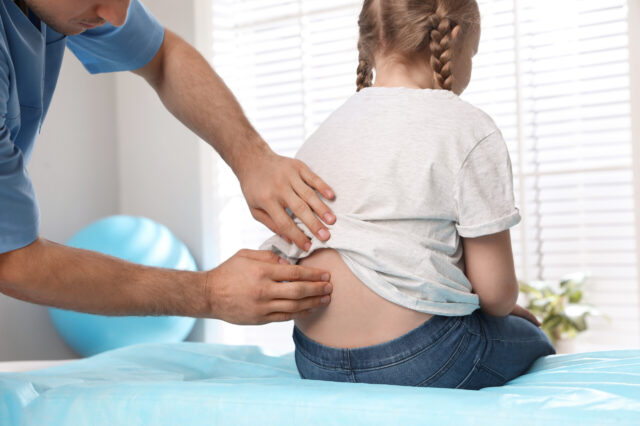Expert Insight for Understanding Scoliosis in Children

Scoliosis is a common condition of the spine, often found in children and young adolescents. Questions about the condition are among the most frequently asked by parents to orthopaedic doctors. We sat down with UF Health pediatric orthopaedic surgeon Dr. Stephanie Ihnow to find out how to recognize, diagnose and treat scoliosis.
What is scoliosis?
Scoliosis is a curvature of the spine. Any curve 10 degrees or more is considered scoliosis. It can affect children of all ages, from birth to teenagers. It is a three-dimensional deformity of the spine where you see an S- or C-shaped curve in the back. There is also a rotational component to it, leading to elevation of the back on one side.
What are some signs to look for in my child?
Scoliosis can be difficult to identify, especially smaller curves or primarily lumbar (lower) curves. Some signs of scoliosis include:
- One shoulder appears higher than the other
- An enlargement on the right or left side of the upper or lower back when you look at your child from the side or when they bend over
- Unevenness of the waistline
- Torso shift — your child may look like their trunk sits to one side or the other compared with their lower body
What is the process for diagnosing scoliosis?
Standing X-rays of the whole spine are the best and most reliable way to diagnose scoliosis. At UF Health, we have a special low-dose X-ray machine, called an EOS machine, that was designed for taking full-length scoliosis X-rays.
What causes scoliosis?
There are many types of scoliosis. Idiopathic scoliosis has no known cause, but it can run in families. Congenital scoliosis is a type of scoliosis that one is born with and is caused by malformation of the vertebrae of the spine. This type can occur on its own or in association with other conditions. Neuromuscular and syndromic scoliosis are types of scoliosis that develop due to an underlying condition, such as cerebral palsy, spina bifida, Prader-Willi syndrome and Marfan syndrome.
Is this something that can correct itself or that my child can grow out of?
Scoliosis is a condition that does not typically correct itself over time and tends to progress when children are growing the most. Very small curves can improve on their own, but curves over 20 degrees tend to progress over time.
Will my child need surgery?
If your child has scoliosis, they may not need surgery. Moderate-sized curves that fall in the 20- to 40-degree range can be treated with bracing or a combination of bracing and physical therapy. The goal of treatment is to stop progression of the curve. Bracing involves wearing a custom scoliosis brace for 18 hours per day until the child is almost done growing. Schroth physical therapy is a special type of physical therapy for patients with scoliosis that focuses on strengthening their back muscles to elongate, de-rotate and stabilize the spine. It is used for mild or moderate curves in combination with bracing.
In younger children, we often use Mehta casting instead of bracing. This is a special cast that is placed in the operating room while the child is asleep. The cast is changed every 2-3 months depending on the patient’s age.
Once a curve progresses, we have a few treatment options. Posterior spinal fusion is the most common surgery performed for scoliosis. This involves placing screws and rods in the back to improve the curve and prevent further progression. Depending on the location of the curve, the flexibility of the curve and the patient’s age, it may be a non-fusion spinal procedure. We offer two non-fusion procedures at UF Health: vertebral body tethering, or VBT, and ApiFix® (a self-ratcheting rod that is placed in the back). Special X-rays are needed to determine whether a patient is a candidate for a non-fusion spinal procedure.
In younger kids (less than 10 years old) who still have a lot of growth left, special rods called growing rods are often used. These include MAGEC rods and traditional growing rods, which allow us to control the curve while also allowing the child’s back to continue to grow.
How will scoliosis affect my child’s quality of life?
When discovered in the early stages and with appropriate treatment, your child can have an excellent quality of life even if surgery is required. Most children have no restrictions and go on to be active, healthy adults. Younger kids with early onset scoliosis also can have a good quality of life when treatment is initiated early.
The treatment course for scoliosis can be a long journey. At UF Health, we take a multidisciplinary approach in treating all types and severities of scoliosis to provide the best outcome for our patients.

